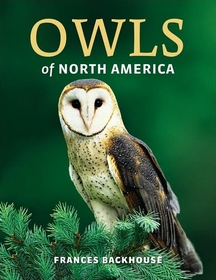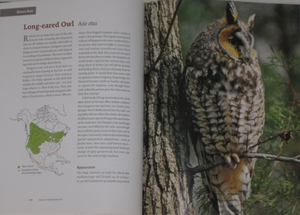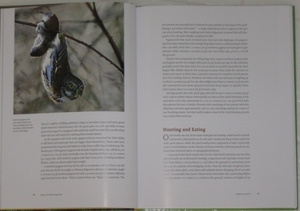Reviewed by Grant McCreary on March 21st, 2009.
What do you think is the most popular bird family in terms of books published about them? I’m not even sure how to find the answer. The best method I’ve come up with is to search for family names within Amazon.com’s birdwatching section, and then compare the number of results that it finds. These numbers are certainly inflated, as they also include general field guides, novels, calendars, etc (161 different books about trogons? I think not). Still, they should give a good idea as to which one is the most popular. Here are a few that I thought would do well: hummingbirds – 608; sparrows – 717; hawks – 766; raptors – 585; ducks – 829. But the most popular, with 884, was owls. That didn’t surprise me (nor should it have you, since this is a review of an owl book!). So did we really need another? What does this one have to add?
Owls of North America presents the biology and behavior of this intriguing family, and introduces those species that call North America home.
Backhouse starts with a brief exploration of the relationship between humans and owls. Throughout history, people have both revered and reviled these birds. There have been some crazy ideas about owls, and some of these superstitions persist even today. Human impacts on owl populations today are also touched upon.
Up next is an initial overview of owls in general, and an introduction to the owl families and genera that are represented in North America.
Subsequent chapters delve into greater detail on the various aspects of owls’ lives, specifically:
- Adaptations for a nocturnal lifestyle
- Feeding
- Communication
- Mating
- Life cycle (including hatching, fledging, and life expectancy)
- Other activities and movements
A remarkable amount of information is presented, but in a way that anyone can understand. It is thorough enough for the target audience, without going into details that only professionals would appreciate.
Backhouse’s style is pretty straightforward. For each topic, general family-wide information is given, supported by species-specific examples. In this way, the reader learns about both the owl family as a whole and individual species. The writing style is also suited to the task at-hand, not flashy, but presenting the information clearly and interestingly enough to keep the reader from becoming bored.
23 species profiles complete the book, which includes all the owls of the United States, Canada, and Mexico north of the tropic of Cancer. The Mexican species that most “North American” birders may be unfamiliar with are Stygian and Mottled Owls, Colima Pygmy-owl, and Vermiculated Screech-owl (although the first two have been found in Texas).
Each of the profiles includes:
- Range map – actually shows the entire North American continent, from Greenland to Panama, as well as most of the Caribbean
- Introductory notes – tells a story, or highlights something about the species
- Appearance
- Voice
- Activity timing and roost sites
- Distribution
- Habitat
- Feeding
- Breeding
- Migration and other movements
- Conservation
These accounts include just about everything that you could want in a book like this. My favorite section was the introductory notes. These were surprisingly fascinating, and covered different topics depending on the bird, including conservation, taxonomy, and biological principles. Unless you’re looking for some specific information, the rest of the species profiles can be skimmed. But the first section of each account deserves to be read in its entirety.
Just over 70 photographs supplement the text. There is a mix of portraits, action shots, and captures of interesting behavior. Some of these you may have seen before (or very similar shots), such as the Great Gray with talons spread, inches away from catching a rodent. But others are startlingly unexpected, like a pygmy owl struggling with prey that’s almost as big as it is! Overall, the images are great and add much to the text.
Everything that is present here, both text and photos, is very good. The only real issue I have is with what is not here. After reading through the book once, it seemed as if there were fewer photographs than there should be. After further examination, I still think that more should have been included, but this impression is exacerbated by the layout. There are very large side margins in order to accommodate captions for the pictures. However, the margins are kept the same size even on pages without pictures. There is something to be said for consistency, but in this case it results in too much wasted space. A more fluid layout, with smaller margins where possible, and the placement of pictures in varying locations on the page would greatly improve the book’s look and feel.
Also, please note that this book’s focus is on natural history, and not the identification and finding of owls. These topics are touched upon tangentially, but not in any depth. I think a short chapter on the subject would have been welcomed.
Other Owl Books
With all of the owl books available, I thought I would give a brief overview of some other books dealing with North American owls.
Surprisingly, I’m aware of only one real, direct competitor to this book – Owls of the United States and Canada: A Complete Guide to Their Biology and Behavior, by Wayne Lynch. Both focus on the biology and behavior of North American owls for nonprofessional readers. I wish I could give a detailed comparison, but I’ve only glanced through the Lynch book. There have to be others that are similar, but I have a hard time believing that they would be as good as these two.
Paul Johnsgard’s North American Owls is similar to Backhouse and Lynch in that it reviews the owl family as a whole and has species accounts for the NA birds. However, it is more technical and has many fewer illustrations. Thus, it would probably appeal more to professionals.
If you’d rather get to know our owls on a species, rather than family, level, then I would highly recommend North American Owls: Journey Through a Shadowed World and Raptors of North America: Natural History and Conservation
(Review). These two will include many of the basic biological facts, but they really focus on the birds on a personal level, based upon the authors’ experiences.
The Owl and the Woodpecker: Encounters With North America’s Most Iconic Birds (Review) includes photographs and information on each of the NA owls, but focuses on their relationships with other birds (especially woodpeckers) and their habitat.
Finally, if you’d like help identifying and finding owls, then there is the aptly named How to Spot an Owl. Owls of the North: A Naturalist’s Handbook
and Field Guide to Owls of California and the West
(which, despite its title, actually covers all the owls of NA) also would help in this regard.
Recommendation
Owls are fascinating creatures. If you’d like to have a light shone into their nocturnal world and learn more about them and their lives, then this book is for you.
Disclosure: I get a small commission for purchases made through links in this post.
Disclosure: The item reviewed here was a complementary review copy provided by the publisher. But the opinion expressed here is my own, it has not been influenced in any way.







Comment